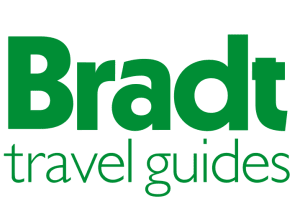DISCOVER AFRICA
Is Gorilla Trekking Safe?
Gorilla trekking is an incredible experience that we cannot recommend highly enough! Especially considering it is really safe.
Gorilla trekking is a risk-free activity if you follow a few simple rules regulations and listen to your trip guide. Gorilla trekking is an incredible experience that we cannot recommend highly enough! Especially considering it is really safe. Mountain gorillas are gentle giants despite their enormous size and might. They have no desire to cause harm to humans. The money collected for gorilla trekking brings in a lot of money for Uganda, Rwanda, and the Democratic Republic of the Congo. A gorilla permit costs $400 in Congo, $700 in Uganda, and $1500 in Rwanda.
Every day, almost 200 individuals monitor mountain gorillas in these nations. For underdeveloped nations, the overall amount collected is rather significant. Countries are prepared to go to considerable lengths to preserve the primates and visitors who come to view them in order to protect this significant source of foreign cash. To that purpose, gorilla conservation programs have been launched to conserve the gorillas with funds raised from tourists. Most national parks employ armed rangers to keep an eye out for poachers. The government also sends in the military to flush out any rebel elements who are taking sanctuary in the parks. Army border patrols assist in monitoring any security incidents that may affect the safety of tourists.
Is Gorilla Trekking Safe?
About security and safety in gorilla tracking destinations, we’d like to begin by mentioning that the people of Uganda, Rwanda, and Congo are exceedingly warm, courteous, and welcoming to international tourists. Uganda and Rwanda are typically calm and safe nations, however as with any other, caution should be exercised when visiting metropolitan cities. Pickpockets pose a genuine menace in major cities. The tourist business in Uganda was harmed by the Kony insurrection in the country’s north roughly ten years ago, but peace has now been entirely restored and the militants have been driven out.
Is gorilla trekking Safe in Congo’s Virunga National Park?
In some areas, the Democratic Republic of the Congo remains insecure. The good news is that we’re dealing with a massive country. Major political storms in the capital and turmoil in certain outlying districts do not often spread throughout the country. The Virunga National Park is safe for visitors doing gorilla trekking. Virunga National Park in Congo is one of Africa’s best-managed parks. It is home to one of the most beautiful lodges in East and Central Africa. Conservationists, as well as local and foreign employees, are among the stakeholders.
The administration of Virunga National Park is concerned about the safety of guests on a safari in Congo and will go to considerable measures to safeguard visitors, even closing the park if required. Visitors to Virunga are constantly accompanied by armed guards and wardens on the watch for poachers and other armed organizations. A tourist to Virunga National Park must acclimatize to and become accustomed to seeing more armed people and weaponry than usual. The park also benefits from the presence of a big detachment of UN soldiers in the adjacent town of Goma – you’ll be astonished to discover a sizable diplomatic population in the vicinity.
Is Gorilla Trekking Safe in Uganda?
Gorilla trekking safaris in Uganda take place at Bwindi Impenetrable National Park and Mgahinga Gorilla National Park. Uganda is home to the most mountain gorillas in Africa. They may be spotted in Mgahinga and Bwindi National Parks. Uganda is also a less expensive gorilla tracking location than Safety and gorilla trekking in Rwanda. There has been no security incident in Bwindi Impenetrable and Mgahinga Gorilla National Parks for over 20 years. Within the parks, the government keeps a military garrison on standby, along with armed rangers and tourist police.
All of these armed employees have been well-trained, equipped, and motivated to keep the park and its visitors secure. The Uganda Peoples Defense Forces (UPDF) conduct secret border patrols to ensure that no rebel members from neighboring countries seek to hide in the forests. All security procedures involve the communities living near the park. They will report any suspicious actions that may endanger passengers since they gain from tourism.
Is Gorilla Trekking in Rwanda Safe?
Rwanda is regarded as one of the world’s safest countries. In Rwanda, your chances of getting robbed or stolen may be lower than in your home nation. Rwanda’s security is strict, and police may be seen practically everywhere. Security is very tight in the national parks, and there are practically no incidences of poaching in Rwanda today. Given the substantial military and police presence in the Volcanoes National Park, rebel fighters from neighboring nations have little chance.
Why Gorilla Trekking is Safe?
Here are a few reasons why we believe gorilla trekking is a safe experience for every adult person to enjoy;
Mountain Gorillas are actually calm and peaceful.
Mountain gorillas, despite their height and power, are relatively calm and tranquil creatures. They are known as “the gentle giants of the forest.” You will see habituated gorilla families. Habituated gorilla groups are those that have become accustomed to human presence – a two-year process. However, like with any other wild animal, care must be given and guidelines must be followed during gorilla excursions.
Mountain gorillas are even vegetarians (most of the time, though they do consume insects). So, while gorillas will defend themselves if they are attacked, they are not violent animals. And they have no desire to play with people.
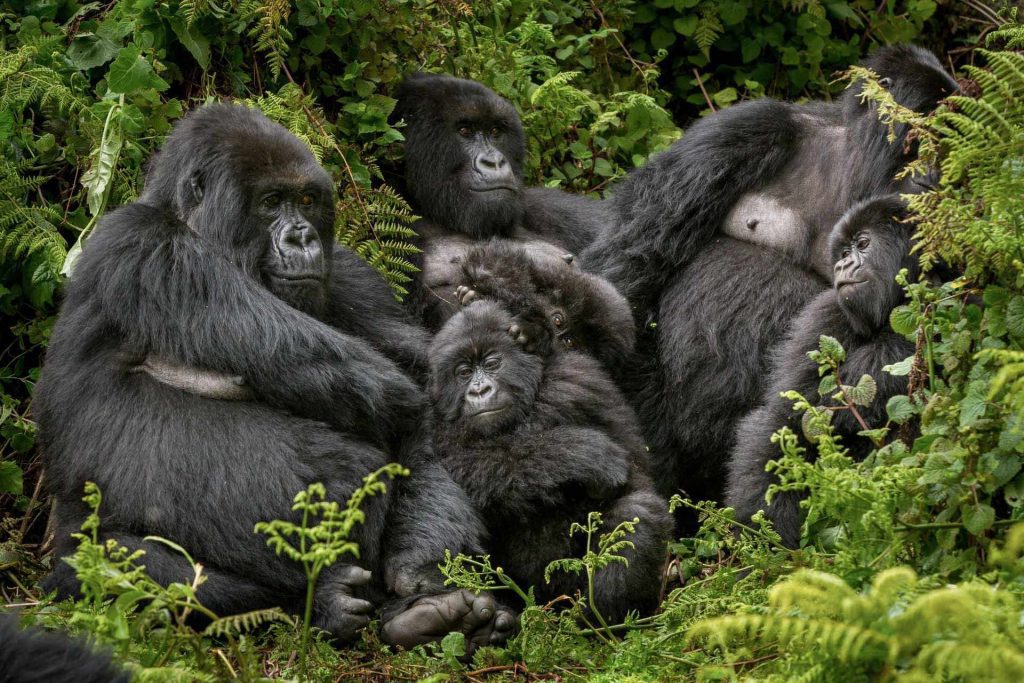

Trek habituated gorilla families.
The fact that the gorilla families you meet on a journey are accustomed adds to everyone’s safety. This indicates they’ve gone through a protracted process of gradually acclimating to the presence of humans. As a result, they are less likely to feel scared or irritated by your presence.
Visitors are accompanied by trained park guides.
Furthermore, when you embark on a gorilla hike, you are accompanied by a certified guide. Such men and women are familiar with the gorilla forces being visited and understand what can and cannot be done. While trekking, it is critical to constantly listen to your ranger and stick with the group. Pay attention to what you’re taught to do and not to do. Poking a silverback’s stomach, for example, is not permitted. However, if you follow the regulations of your tour guide and use common sense, you will be entirely safe when viewing the gorillas.
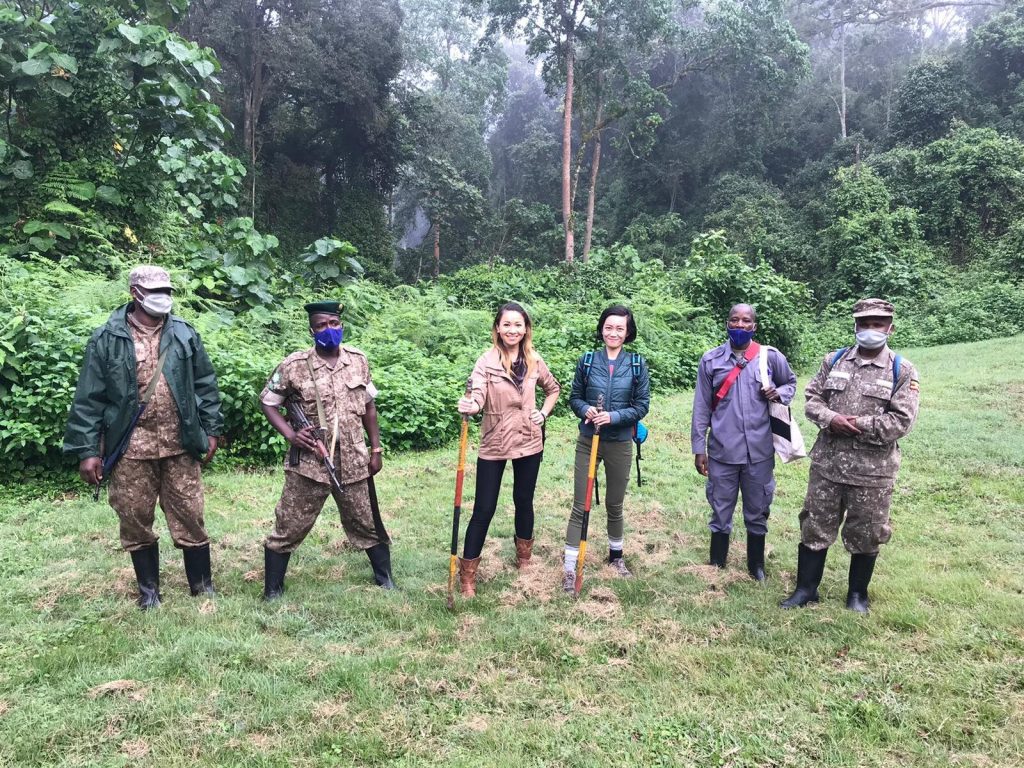

Gorilla Treks in the forest are Safe.
Mountain gorillas dwell in montane forests, thus finding them requires walking along forest routes. After all, a gorilla expedition is all about viewing these wonderful animals in their native habitat. The duration and complexity of each forest trek vary based on a few things, including the park you visit, the weather, and the exact gorilla troop you’ve been allocated park rangers monitor troop positions, and each trek party is assigned a certain troop to see.
In general, visitors can request to be allocated to a troop near or far from the starting place. Those who are less fit, for example, may choose a shorter trek. Hikes last anything from 30 minutes to three or four hours. There are no overnight treks available.
Tips and Regulations for Gorilla Trekking Safety.
Obviously, there are guidelines to observe when monitoring the gorillas to avoid angering, intimidating, or otherwise disturbing the gorillas. To further guarantee that everything runs properly in the company of mountain gorillas, here are some easy suggestions to follow: To obtain a gorilla tracking permit, you must be at least 15 years old. The age restriction for gorilla trekking is imposed at 15 years old because youngsters often carry flu, colds, chickenpox, and mumps, which can infect the gorillas.
To enter Uganda, Rwanda, or Congo, you must have a yellow fever vaccine. Foreign tourists may also require a visa to access the various gorilla-tracking destinations. After the briefing and before entering the jungle, the park officials will request your passport to validate your identification and guarantee that you are eligible for gorilla trekking. A gorilla group can only have eight visitors each day. This not only reduces the likelihood of illness transmission but also minimizes disruptions to the gorilla group’s behavior.
Trekking gorillas in Uganda, Rwanda or Congo entails traveling large distances in search of gorilla families. It frequently entails ascending high slopes and navigating muddy routes. For the optimal experience, you should be relatively fit and in decent form. Elderly visitors will be placed to the closest gorilla families. If the elderly choose, they can employ a porter to help take them up to the group.
When sick with communicable illnesses, it is impossible to trace mountain gorillas. If the Rangers believe the gorillas are sick, they have the authority to prevent you from continuing with the group. If you’re not feeling well or fear you have a contagious sickness, offer to stay behind. Once you have been cleared and are in excellent health, you will be reimbursed the money you paid on the permit or given another opportunity. Human illnesses such as diarrhea, fever, and cough are easily transmitted to gorillas. Cough, in particular, has a negative impact on gorillas. If you need to sneeze or cough, turn away from the gorillas and cover your nose and mouth. Keep in mind that you may be carrying germs or an ailment that you are unaware of. You should also make sure you have clean hands before going trekking.
Pay close attention and follow what the Rangers say. Don’t chat too loudly while hiking to avoid missing out on possibilities to see birds and other woodland wildlife. Maintain a quiet tone while among the primates. If you must speak, do it in whispers. Loud noises can startle gorillas, especially if they have recently finished the habituation process. If you are bitten by an insect or a safari ant, do not scream or alarm the gorillas. They may depart before the hour is over, lowering the amount of time spent with them. Inform the rangers of your situation, and they will provide you with a solution.
Keep the park clean and clear of trash that might infect the gorillas. Tourists are not permitted to leave handkerchiefs, used tissues, or canisters. The primates may potentially ingest the things, causing difficulties. If you need to use the restroom, notify the guide immediately. They will dig a hole for you, which you must cover afterward to prevent disease transmission to the gorillas.
Do not remove vegetation to obtain a closer look at the gorillas. This might frighten the primates. Allow the rangers to undertake whatever required and possible clearance. In the presence of mountain gorillas, do not eat, drink, or smoke. They may approach you out of curiosity and maybe bite you. Leftover food might include viruses that are harmful to gorillas.
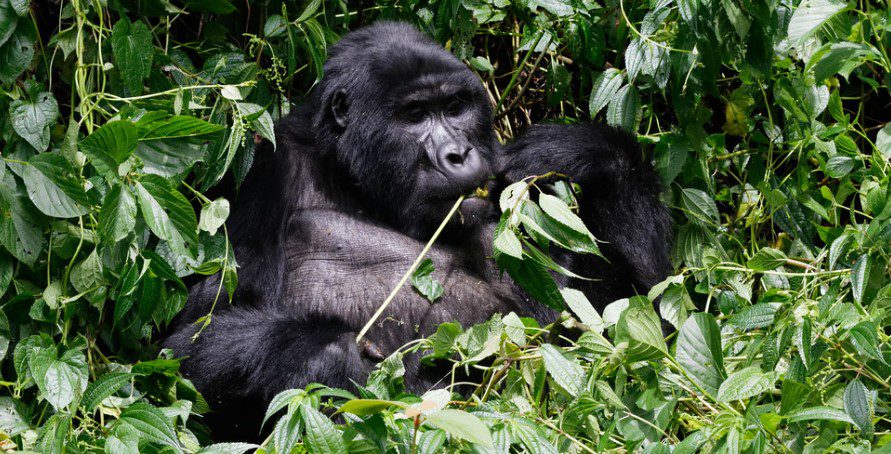
Keep a safe distance from the gorillas.
To decrease the risk of transferring human infections, keep at least 15 feet away from endangered mountain gorillas. Tourists should avoid surrounding the gorillas and instead observe them in groups. The gorillas should have enough room to walk about without feeling encircled or frightened. Maintaining a 15-foot gap is critical, especially if a gorilla tries to approach you. Slowly reverse your steps. If moving backward is not an option, the only choice is to remain motionless. Juveniles are especially curious and will want to inspect you.
Your things and bag should be closed and secured so that they do not attract the attention of the curious kids. Aside from limiting illness spread, keeping a safe distance will protect the primates from becoming too used to people. It will also prevent the primates from becoming overly acquainted, if not violent, with groups following you.
Keep Calm in case a gorilla charges at you.
If a mountain gorilla charges you, kneel down slowly. Do not flee, but rather let the gorilla to depart on its own. When a silverback begins thumping his chest to demonstrate dominance, the Rangers will be on high alert. They are trained to calm down tourists in such situations and to prevent anyone from fleeing. Staying still is the greatest option, no matter how menacing or frightening the charging seems. Stay cool at all times and avoid making unexpected moves.
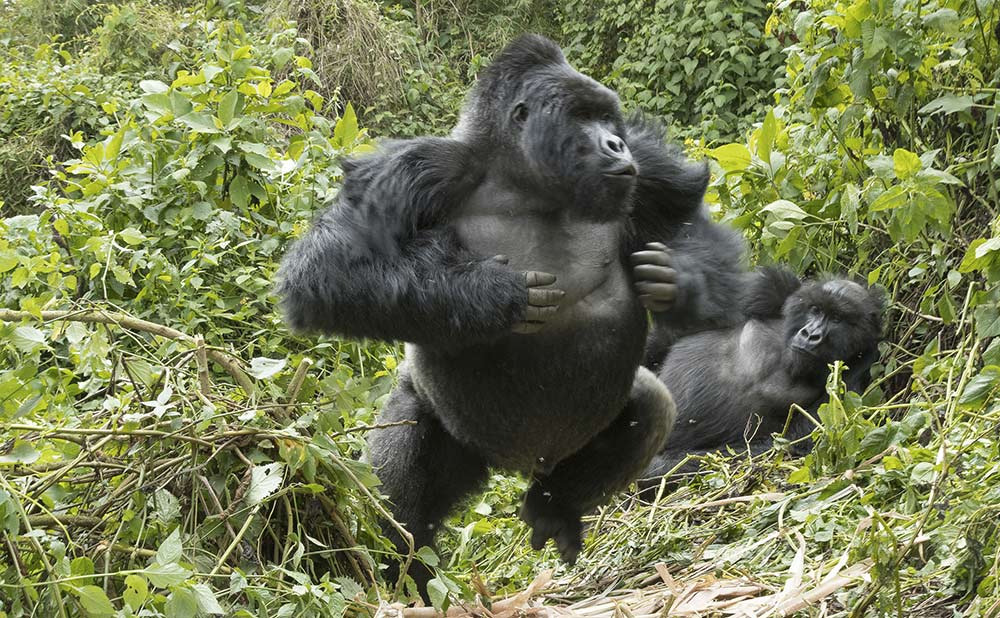
Avoid making eye contact with gorillas
Avoid gazing straight at the gorillas because they may misinterpret it as aggression. When dealing with gorillas, your body language is really important. Lifting your arms or hands may be interpreted as a show of aggressiveness. Standing higher than them and then gazing may sometimes be misinterpreted as aggressive behavior.
Don’t use Flash Photography.
The Rangers will notify you when it is safe to begin shooting photographs. Keep cool and restrict your movements when photographing mountain gorillas. To prevent upsetting the gorillas to the point of rushing at you, don’t use your flash.

Book your gorilla safari with a reputable tour operator company.
Before scheduling your gorilla trekking safari in Uganda, Rwanda or Congo, make sure your tour provider is legitimate. The tour firm must be registered and have already served other clients. Check out TripAdvisor for gorilla trekking reviews to see what other travelers are saying about your trip organization. Find out if they have a company bank account or an internet payment system that can only be issued to legitimate businesses before making any payments. Never transfer funds to individual accounts.
In conclusion; gorilla trekking is a safe adventure and can be done with your family as long as each member is aged 15 years and above. We urge that you grab a group of friends or loved ones and come on over for an unforgettable experience!

